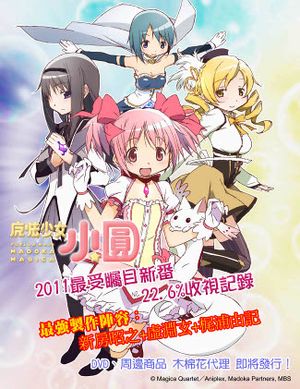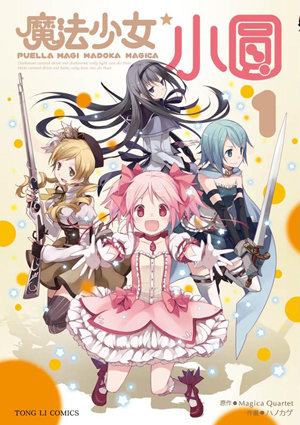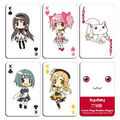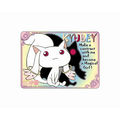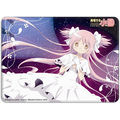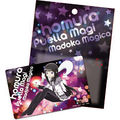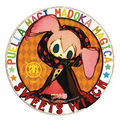Licensing in Taiwan
Anime
The anime version of Madoka (Chinese Title: 魔法少女小圓 Mófǎ Shàonǚ Xiǎo Yuán, "Magical Girl Madoka-chan") is licensed by Muse Communication Co.,Ltd. (木棉花國際股份有限公司 Mùmiánhuā Guójì Gǔfèn Yǒuxiàn Gōngsī) in Taiwan. The 12 episodes will be released in 4 DVD/BD discs with 3 episodes each. Chinese translations of the booklets and 4-koma are included in each volume, however, neither the soundtrack/drama CDs nor the commentaries are included. The audio is in Japanese with Chinese subtitles, but there is no Mandarin dub.
- The first volume DVD (NT$400) was released on Oct 3, 2011. Includes a limited-edition collector's box to house all four DVDs.
- The second volume DVD (NT$400) was to be released on Nov 2, 2011. However, due to problems with the mastering quality, the second volume was delayed until Nov, 18 2011. The revised DVD volume 2 comes with a 42×59cm limited-edition poster painted by Aoki.
- The third volume DVD can be pre-ordered starting from Nov 28, 2011. It will be released on Jan 4, 2012.
Details for the BD version have also been revealed. The pre-orders for the first volume will start on Nov 28, 2011. The other 3 disks can be pre-ordered on Jan 30, Mar 29, and May 30, 2012. Each BD volume will cost NT$800.
Text on the image to the right:
Magical Girl Madoka-chan
- The most attention-grabbing new anime in 2011 with a 22.6% viewership record.
- The strongest lineup of staff: Akiyuki Shinbo + Gen Urobuchi + Yuki Kajiura.
- The DVD and related merchandise will soon be released by Muse!
Manga
It was announced earlier in June 2011 that Tongli Publishing Co. (東立出版社 Dōnglì Chūbǎnshè) licensed the manga version for Taiwan and Hong Kong.
- The first volume (NT$110) was released on Aug 13, 2011 in Taiwan and on Aug 12, 2011 in Hong Kong (HK$35). The limited-edition version comes with a sticker of either one of magical girls or Kyubey.
- The second volume (NT$110) was released on Oct 7, 2011 in Taiwan and on Oct 10, 2011 in Hong Kong (HK$35).
- The third volume (NT$110) was released on Dec 7, 2011 in Taiwan. The first prints are bundled with both volumes of Oriko Magica manga and a limited-edition collector's box for NT$330.
On November 2011, Tongli Publishing Co. announced that they also got the license to publish the Oriko Magica manga. Both volumes will be released along with Madoka volume 3. A limited-edition collector's box will be given to customers who purchase Madoka volume 3 and both Oriko volumes together. The Oriko manga is translated as 魔法少女小織 (Mófǎshaònyŭxiaŏzhī)
On December 2011, Tongli Publishing Co. announced the translated Kazumi Magica manga will be coming soon. They are translated as 魔法少女和美(MófǎshaònyŭHéMeĭ)
Merchandise
In addition to the anime, Muse is also in charge of the merchandising for Madoka in Taiwan.
- 1000-piece Jigsaw Puzzle Size: 75×50cm (NT$300)
- Large Folder A (Madoka & Homura) Size: 22×31cm (NT$50)
- Large Folder B (Charlotte) Size: 22×31cm (NT$50)
- Mini Playing Cards Size: 4.3×6.7cm (NT$80)
- Mousepad A (PVC) (Kyubey) Size: 16×22cm (NT$90)
- Mousepad B (PVC) (Madoka) Size: 16×22cm (NT$90)
- Reproduction Pictures Collection Size: 21×29.7cm (NT$299)
- Large Bath Towel Size: 80×140cm (NT$1200, NT$900 each for purchases of 10 or more)
- Three layered folder Size: 22x31 cm (NT$99)
- Card paste (Homura) Size:8.6*5.4cm (NT$30)
- Water-proof paste type A (Kyubey) Size:12*12cm (NT$30)
- Water-proof paste type B (Charlotte) Size:12*12cm (NT$30)
- Huge Madoka Mugcup Size:31.8*12cm (NT$399)
BD/DVD and Manga
Translation
General notes
Rendering of Japanese names in Chinese is somewhat atypical for Western reasoning and may be confusing for those unaware of it. The general rules are:
- Names written in kanji are pronounced as the characters are normally read in Chinese (eg. 本田 Honda becomes "Běn-tián" in Chinese).
- Names written originally in kana have to be mapped into Chinese characters in some way. There are two ways to do that:
- If the name has a common kanji spelling (eg. まどか Madoka has a common homophone variant 円 also pronounced Madoka), its pronounciation in Chinese is used.
- Otherwise, characters are selected based on the pronounciation. However, Japanese sounds cannot be accurately reproduced in Chinese, so some distortion inevitably occurs. Note, however, that those translation often can also be pronounced exactly as the original names when read as Japanese kanji, as is the case with characters from Madoka.
For the reverse case (ie. Chinese proper names being used in Japanese), on-yomi kanji readings of Chinese characters are usually used. They are based on actual Chinese pronounciation from the time they have been introduced in Japan, so the pronounciation is usually more similar to the original than in the reverse case, but still, due to many changes in both Japanese and Chinese over the centuries, a significant distortion occurs. For example, the famous revolutionary leader 毛泽东 (simplified) / 毛澤東 (traditional) Máo Zédōng is known as 毛沢東 Mou Takutou in Japan.
Note that the characters used in Japanese and Chinese names may still look different, as demonstrated by both Madoka's name and the Mao Zedong example. Taiwan predominantly uses the Traditional Chinese script, on which the Japanese kanji are based. However, some common kanji has been independently simplified in Japanese, which didn't occur in Chinese. For this reason, the character 円's counterpart in Traditional Chinese is 圓. Semantically, they are the same character, though.
If Madoka is ever to be released in mainland China, where the Simplified Chinese script is used, the names are likely to be the same in meaning and pronounciation to the Taiwanese version, but the characters would be different, eg. 円/圓 in Simplified Chinese is written 圆.
Names of the main characters
- Madoka: 圓 Yuán (ofted called 小圓 Xiǎo-yuán "Little Yuán", similar to Japanese "Madoka-chan") - common kanji spelling used
- Homura: 燄 Yàn - common kanji spelling used
- Sayaka: 沙耶香 Shā-yé-xiāng (Madoka calls her 小香 Xiǎo-xiāng) - phonetic substitution used; for the short version, just the last character is retained
- Mami: 麻美 Má-měi - phonetic substitution used
- Kyoko: 杏子 Xìng-zi - name originally in kanji
- Kyubey: 丘比 Qiū-bǐ - phonetic substitution used
